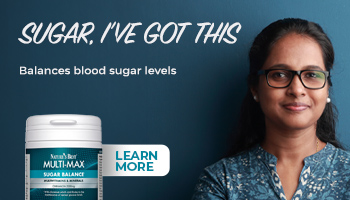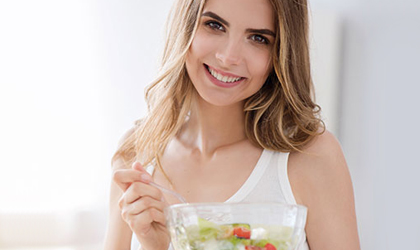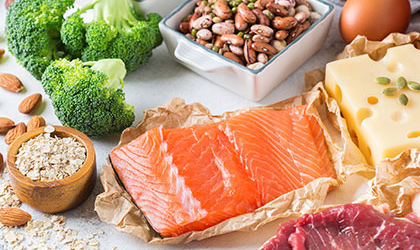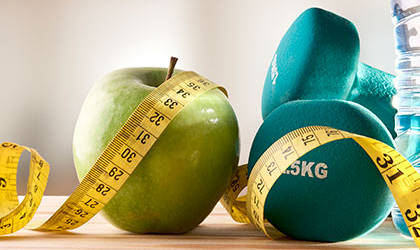
You’re probably very familiar with how blood sugar can impact your mood and energy. Aside from short-term shakiness, lack of focus, and mood swings, chronically imbalanced blood sugar levels can have a long-term effect on your health and happiness. It’s a glucose rollercoaster you don’t want to be on. Using diet to help flatten the glucose curves can help you to stop the cycle in its tracks.
What foods should you avoid if you have low blood sugar?
Changing what and how you eat is one of the best ways to manage your blood sugar levels. Smoother glucose curves mean you’ll be on the road to increased energy, fewer cravings, better hormonal regulation, improved mental health, clearer skin, and better overall wellbeing.

Skip carbs as a starter
Starting a meal with starch will lead to a glucose spike, followed by a crash later on, which will only intensify food cravings. So, as difficult as it is – especially if you’re in a restaurant and they place a delicious doughy bounty under your nose – try to avoid eating bread before anything else. And if you want to enjoy some with your meal, just eat it last.
Rethink your sugar intake
Sugar is lurking in all kinds of places and this – along with the consumption of obviously sugary foods (doughnuts, we’re looking at you) – isn’t great for us. The body breaks sugars down very easily, causing an almost immediate spike in blood sugar. Studies show that excessive sugar consumption is associated with developing insulin resistance and type 2 diabetes (8). Weaning yourself off sugar is hard, but reducing your intake is one of the best things you can do for your health.
Of course, there’s nothing to say you can’t still enjoy sweet foods in moderation when included as part of a healthy, balanced diet. If you have a hankering for something sweet, always choose to have it after a meal as dessert instead of a snack. This way, the sugar will land in a full stomach, meaning it will cause a slower absorption of glucose and, therefore, a smaller spike in blood sugar. Try to avoid having sweet food on an empty stomach or between meals as it will create a greater glucose spike.
Swap sugary beverages and energy drinks with water, plain milk, or tea and coffee without sugar. Fruit juices can be a useful contribution to your 5-a-day but are likely to be high in sugar. Try diluting the fruit juice with water to reduce the sugar content or opt for a fruit and vegetable smoothie instead. Where possible choose ‘whole foods’ – foods in their whole form that are naturally free from added sugar. Always read the labels. Baked beans, pasta sauces, tomato ketchup, yoghurts and ready meals are often packed with hidden sugars.
Be careful with sugar alternatives
The likes of maple syrup, honey, dates, agave, coconut sugar, and molasses may be sold to us as ‘healthy’ sugars, but they still lead to a spike in blood sugar levels, so exercise caution around these, too.
Watch your fruit intake
It may surprise you to learn fruit contains fructose, which is a simple sugar, meaning it can still spike your glucose levels. Where possible, try to pair fruit with fats or protein to flatten the blood sugar curve. For instance, have an apple with almond butter or strawberries with Greek yoghurt and seeds. Both options are crammed with protein and healthy fats, helping to minimise a blood sugar spike.
How do carbs affect blood sugar?
Carbohydrates are broken down into glucose, meaning they affect your blood sugar levels more than fats or protein. Let’s face it: life would be pretty boring without carbs. Pasta and bread are some of the finest pleasures. And the good news is that you can still have your carbs and eat them, too, while managing your blood sugar levels.
Simple vs. complex carbs
Carbohydrates are broken down into glucose, meaning they affect your blood sugar levels more than fats or protein. And yet, not all carbs are created equal.
Simple carbohydrates, such as processed ‘beige’ foods like white pasta, bread, and rice, breakfast cereal and sweets are broken down quickly by the body and cause glucose levels to spike almost immediately.
Complex carbohydrates, on the other hand, are broken down more slowly and cause blood sugar levels to rise gradually. Examples of healthy, complex carbs are whole grains (quinoa, buckwheat, and whole-wheat pasta), fibre-rich veggies (carrots, leafy greens, and cauliflower), fibre-rich fruit (berries and apples), and beans.
What is a good diet for someone with low blood sugar?
Far from a novel diet strategy, people have been using meal sequencing for years. And there’s good scientific research to suggest that just by eating food in the right order during a meal, you can reduce glucose spikes by up to 75% (4). This tool will never go out of fashion because it complements our human physiology so well.
The optimal sequence for stabilising blood glucose levels is…
First: Vegetables (fibre)
Second: Proteins and fats
Last: Starches and sugars
For example in a meal consisting of salmon, potatoes, and salad, you’d eat the salad first, salmon second, and potatoes last.
How does food ordering work?
The main reason this nifty hack helps reduce glucose spikes is down to our little friend, fibre: fibre reduces both the quantity and speed at which glucose is absorbed later in the meal. And so, if you’re eating your meal in that order, you’ll have a smaller glucose spike. That means fewer cravings, more energy, and improved satiety. This doesn’t mean you have to pick apart every meal. It’s just something to keep in mind. You could have a fibre-rich vegetable-based starter, followed by your regular meal, for instance. Don’t worry if you can’t do it all the time; do it when it’s easy, available, and you feel like it.
Hypoglycaemia nutritional treatment
Aside from making changes to what you eat and how you eat, adding certain foods to your diet may also help manage your blood sugar levels.
Try carb layering
Anchoring your carbs with other food groups is the secret to minimising a blood sugar spike. Science tells us that combining fats, protein or fibre with carbs (even complex carbs, like brown rice) significantly lowers the increase in blood glucose (5). So, don’t leave your carbs naked; always put some clothes on them!
The best clothing for your carbs is fibre. Combining carbs with fibre means the glucose from the starchy food won’t hit your bloodstream as quickly, resulting in a smaller spike. Instead of reaching for plain bread – guaranteed to spike your blood sugar immediately and lead to an energy crash – why not enjoy it with some protein-dense hummus and fibre-rich avocado?
Cool down your starches
Did you know cooling down starchy food, such as potatoes, for at least 20 minutes in the fridge (don’t worry, you can heat them again!) creates resistant starch, which acts similar to fibre and triggers a smaller glucose spike? (6). You don’t need to do this all the time; only when it’s easy and you fancy it.
Limit your snacks
In 2014, scientists in the Czech Republic conducted a study on two groups: one group ate two meals daily; the other ate six (9). Both groups consumed the same number of calories throughout the day. The group who ate two meals experienced healthier glucose levels and more weight loss. Researchers concluded that eating fewer meals – and fewer snacks – was a better choice for blood sugar management.
That said, everyone in the wellness space has an opinion on snacking, especially when it comes to blood sugar management. The bottom line is if you decide to snack, do so wisely – and always with your blood sugar in mind. Choose steady-glucose snack ideas that hit all the nutritional points known to balance your blood sugar including a source of fibre, protein, and healthy fats such as:
-
Apple with nuts and almond butter
-
Hummus with cucumber and carrots
-
Chia pudding with peanut butter and berries
-
Seeded crackers with baba ganoush (roasted aubergine dip)
-
Two boiled eggs with avocado
Nuts for the win
Nuts are the ultimate healthy snack. And they’re particularly great for your blood sugar levels. In a recent study, researchers found that eating 70 pistachios daily for 4 months reduced fasting glucose levels, led to fewer cravings, and improved cholesterol (10). Of course, eating 70 pistachios a day is a tall order. A handful will suffice if you fancy.
Gut health and sugar
The gut is having its moment in the spotlight for good reason. This extraordinary entity appears to affect far more than just the digestive system; it influences mood, immunity, brain, skin, and bone health. And now, research suggests the state of your gut microbiome may even impact your blood sugar levels (11). According to gut expert Dr Megan Rossi, we should all be aiming for 30 different plant foods a week to support gut health (12). This doesn’t just mean eating more fruit and veggies; this number includes all plant foods: grains, legumes, nuts, seeds, herbs, and spices.
Consider what you’re drinking
When it comes to managing your blood sugar, it’s not just your eating habits that count; what you drink can also make a huge difference. It turns out water shines in the blood sugar department, too. Research has found that drinking enough water may help control blood sugar levels, flushing out excess glucose through urine. One study found that increasing water intake may prevent or delay the onset of hyperglycaemia (where blood sugar is too high) (13).
Aim for 2 litres of water daily – and try to spread your consumption out throughout the day.
Vinegar and blood sugar levels
Although more research is needed, some preliminary data suggests having a tablespoon of vinegar before a meal, either in water or as a dressing on a vegetable-based starter, may curb the glucose spike of that meal by up to 30% (14).
Vinegar contains a magical molecule called acetic acid, which is known to impact the body in two ways: firstly, it slows the breakdown of starch into glucose; secondly, it encourages your muscles to uptake more glucose as it arrives in your bloodstream. As a result, it may make the glucose spike of your meal smaller.
For this, you could use white wine vinegar, red wine vinegar, or apple cider vinegar. Try sparingly so for example, you don’t need to have it with every meal and if it doesn’t agree with you, stop. Remember to always dilute vinegar in water and you can use a straw as that will be better for your teeth.
Supplements for low blood sugar
Aside from making changes to what you eat and how you eat, adding certain foods to your diet may also help manage your blood sugar levels.
Chromium for sugar cravings
Chromium often comes into its own when discussing blood sugar health. An essential mineral, chromium is known for contributing to the maintenance of normal blood glucose levels, making it a great addition. You can find chromium in egg yolks, Brazil nuts, tomatoes, and broccoli.
Omega 3
Abundant in oily fish, the long-chain fatty acids DHA and EPA, play a role in heart health, which is important, since heart health is often compromised by poor blood sugar management. A good rule of thumb is to aim for two to three portions of oily fish every week. For those who don’t eat fish, algae oil – known for being extremely rich in DHA – is a great alternative.
Consider herbs that lower blood sugar
Aromatic and fragrant, cinnamon has been used in traditional medicine for years. There’s some evidence to suggest this spice may play a role in blood sugar management (17). Add cinnamon to baked goods, hot beverages, and root vegetables. Fenugreek seeds are high in fibre, which may slow down the digestion and absorption of carbohydrates. Thanks to their nutty, bitter taste, fenugreek seeds pair perfectly with Indian curries, sauces, and pickles.
Want to find out more?
Read more of our resources on health here. You can also reach out to our expert Nutrition Advice team via email, phone or Live Chat to receive free nutrition advice. No matter how small your query, they’re happy to help.
FREE EXPERT NUTRITION ADVICE.
Call: 01892 352927
Email: nutrition@naturesbest.co.uk
Write: Nature’s Best Ltd. Century Place, Tunbridge Wells, Kent, TN2 3BE
References
-
Hall, H.,et al., Glucotypes reveal new patterns of glucose dysregulation. PLOS Biology, 16(7), e2005143. 2018-07-03.
-
Shukla, A., Iliescu, R., Thomas, C., & Aronne, L. (2015). Food Order Has a Significant Impact on Postprandial Glucose and Insulin Levels. Diabetes Care, 38(7), e98-e99.
Nishino K. et al., Consuming carbohydrates after meat or vegetables lowers postprandial excursions of glucose and insulin in nondiabetic subjects. Journal of Nutritional Science and Vitaminology, 2018;64(5):316-320.
Tricò, D., Filice, E., Trifirò, S. et al. Manipulating the sequence of food ingestion improves glycemic control in type 2 diabetic patients under free-living conditions. Nutr & Diabetes 2016;6:e226. -
Lilly LN, et al. The Effect of Added Peanut Butter on the Glycemic Response to a High-Glycemic Index Meal: A Pilot Study. J Am Coll Nutr, 2019;38(4):351-357.
Jenkins DJA. et al., Almonds Decrease Postprandial Glycemia, Insulinemia, and Oxidative Damage in Healthy Individuals. The Journal of Nutrition, 136(12), 2987–2992 (2006). -
Macdonald IA., A review of recent evidence relating to sugars, insulin resistance and diabetes. Eur J Nutr. 55 (Suppl 2): 17-23.2016.
-
Kahleova, H. et al., Eating two larger meals a day (breakfast and lunch) is more effective than six smaller meals in a reduced-energy regimen for patients with type 2 diabetes: a randomised crossover study. Diabetologia. 2014 Aug;57(8):1552-60.
-
Baghery, F., Mohammadifard, N., Khanamani Falahati-Pour, S.. The effect of pistachio supplementation on metabolic syndrome and its components in adults: a systematic review and meta-analysis of randomized controlled trials. Nutrition Reviews. 2022;nuac027.
-
Utzschneider, K. M., Kratz, M., Damman, C. J., Hullar, M., Mechanisms Linking the Gut Microbiome and Glucose Metabolism. J Clin Endocrinol Metab. 2016 Apr;101(4):1445-54.
-
How to get your gut-loving 30 plant points a week - The Gut Health Doctor. (2022). Available online: https://www.theguthealthdoctor.com/how-to-get-your-gut-loving-30-plant-points-a-week/
-
Roussel, R. et al., Low Water Intake and Risk for New-Onset Hyperglycemia. Diabetes Care, 2011 Dec; 34(12):2551-4.
-
Mitrou, P. et al., Vinegar Consumption Increases Insulin-Stimulated Glucose Uptake by the Forearm Muscle in Humans with Type 2 Diabetes. J Diabetes Res. 2015;175204.
-
Jarvill-Taylor, KJ, et al. , A hydroxychalcone derived from cinnamon functions as a mimetic for insulin in 3T3-L1 adipocytes. J Am Coll Nutr. 2001;20(4):327-36.
Related Posts
Disclaimer: The information presented by Nature's Best is for informational purposes only. It is based on scientific studies (human, animal, or in vitro), clinical experience, or traditional usage as cited in each article. The results reported may not necessarily occur in all individuals. Self-treatment is not recommended for life-threatening conditions that require medical treatment under a doctor's care. For many of the conditions discussed, treatment with prescription or over the counter medication is also available. Consult your doctor, practitioner, and/or pharmacist for any health problem and before using any supplements or before making any changes in prescribed medications.

Olivia
Olivia Salter has always been an avid health nut. After graduating from the University of Bristol, she began working for a nutritional consultancy where she discovered her passion for all things wellness-related. There, she executed much of the company’s content marketing strategy and found her niche in health writing, publishing articles in Women’s Health, Mind Body Green, Thrive and Psychologies.
View More



